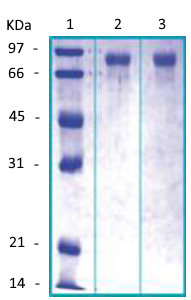FGF 21 His Recombinant Protein
Shipping Info:
For estimated delivery dates, please contact us at [email protected]
| Amount : | 10 µg |
| Purification : | Greater than 90.0% as determined by SDS-PAGE. |
| Content : | The FGF-21 His tag protein solution in 20mM Tris-HCl buffer pH-8 and 10% glycerol. |
| Storage condition : | Store at 4°C if entire vial will be used within 2-4 weeks. Store, frozen at -20°C for longer periods of time. For long term storage it is recommended to add a carrier protein (0.1% HSA or BSA).Please avoid freeze thaw cycles. |
| AA sequence : | MGSSHHHHHH SSGLVPRGSH MHPIPDSSPL LQFGGQVRQR YLYTDDAQQT EAHLEIREDG TVGGAADQSP ESLLQLKALK PGVIQILGVKTSRFLCQRPD GALYGSLHFD PEACSFRELL LEDGYNVYQS EAHGLPLHLP GNKSPHRDPA PRGPARFLPL PGLPPAPPEP PGILAPQPPD VGSSDPLSMV GPSQGRSPSY AS. |
| Alternative Name : | Fibroblast growth factor 21, FGF-21. |
Source : Escherichia Coli. Fibroblast Growth Factor -21 Human Recombinant produced in E.Coli is a single, non-glycosylated, polypeptide chain containing 202 amino acids (29-209) and having a molecular mass of 21.6 kDa (molecular weight on SDS-PAGE will appear higher). The FGF-21 is fused to a 20 amino acid His Tag at N-terminus and purified by proprietary chromatographic techniques. The FGFs are a family of more than 20 small (~17-26 kDa) secreted peptides. The initial characterization of these proteins focused on their ability to stimulate fibroblast proliferation. This mitogenic activity was mediated through FGF receptors (FGFRs) 1, 2, or 3. A fourth closely related tyrosine kinase receptor (FGFR4) was able to bind the FGFs but did not lead to a mitogenic response.FGFs modulate cellular activity via at least 5 distinct subfamilies of high-affinity FGF receptors (FGFRs): FGFR-1, -2, -3, and -4, all with intrinsic tyrosine kinase activity and, except for FGFR-4, multiple splice isoforms, and FGFR-5, which lacks an intracellular kinase domain. There is growing evidence that FGFRs can be important for regulation of glucose and lipid homeostasis. The overexpression of a dominant negative form of FGFR-1 in cells leads to diabetes in mice, which thus implies that proper FGF signaling is required for normal cell function and glycemia maintenance. FGFR-2 appears to be a key molecule during pancreatic development. Moreover, FGFR-4 has been implicated in cholesterol metabolism and bile acid synthesis.FGF-19, has been shown to cause resistance to diet-induced obesity and insulin desensitization and to improve insulin, glucose, and lipid profiles in diabetic rodents. Since these effects, at least in part, are mediated through the observed changes in metabolic rates, FGF-19 can be considered as a regulator of energy expenditure.FGF-21 is preferentially expressed in liver, but an exact knowledge of FGF-21 bioactivity and its mode of action have been lacking to date. FGF-21 is a potent activator of glucose uptake on adipocytes, protects animals from diet-induced obesity when overexpressed in transgenic mice, and lowers blood glucose and triglyceride levels when therapeutically administered to diabetic rodents.
Measured in a cell proliferation assay using NIH-3T3 cells. The ED50 for this effect is <12ng/ml, which corresponds to > 83,000 units/ml.
For Research Use Only. Not for use in diagnostic/therapeutics procedures.
|
There are currently no product reviews
|

















.png)








